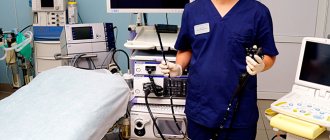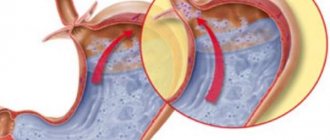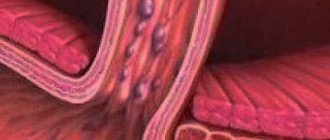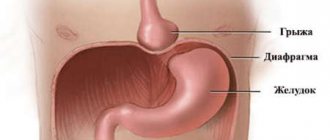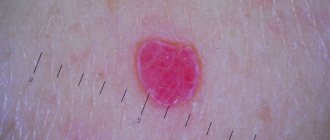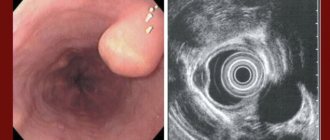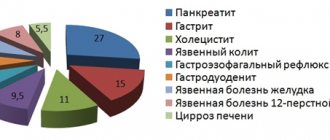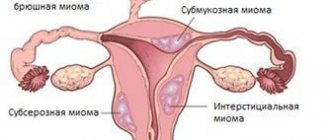Esophageal spasm is a contraction of the smooth muscles of the organ, in which the act of swallowing is disrupted, accompanied by pain in the retrosternal region, but the lower esophageal sphincter (LES) functions normally.
The disease manifests itself as sharp pain in the chest, dysphagia, belching, regurgitation of food eaten, and heartburn. The diagnosis is made on the basis of X-ray examination, endoscopy, manometry of the esophagus; for the purpose of differential diagnosis, pH-metry of the esophagus is performed. Treatment is mainly conservative: diet therapy, therapy aimed at reducing intra-abdominal pressure and reducing myotonus of the esophagus.
ICD 10 K 22.4
Esophageal spasm: symptoms and causes
Among the reasons leading to the occurrence of esophageal spasm (esophagospasm), the main ones are the following:
- Hard, insufficiently chewed, dry, too hot or cold food.
- Microtraumas of the walls, which can be formed as a result of damage from hard food or foreign bodies.
- High-strength alcoholic drinks, which can cause burns to the mucous membranes.
- Food or chemical poisoning.
- Intercostal neuralgia associated with the functioning of the digestive organs.
- Infectious diseases affecting the mucous membrane - acute bronchitis, influenza infections, measles, rubella, scarlet fever.
- Inflammatory processes in the internal organs near the esophagus.
- Stomach or duodenal ulcer, gallstones.
- Gastroesophageal reflux pathology, one of the manifestations of which is the reflux of stomach contents back into the esophageal cavity.
- Diseases of the nervous system.
- Overwork, psycho-emotional stress and stress.
Spasms are most often recorded at the entrance or exit of the esophageal tube. These areas are supplied with a large number of nerve endings, so they are the first to respond to malfunctions of the nervous system. The function of the esophageal sphincters is to prevent inappropriate food from entering, and therefore there is a sharp reduction in contact with hot, spicy or hard foods.
Signs of pain can be acute - in the form of intense cutting pain or a feeling of “lump”, tightness and heaviness. The duration of the attack ranges from a couple of seconds to one hour.
The main symptom of esophagospasm is chest pain.
The main symptoms of an attack are:
- Acute pain in the chest and area between the shoulder blades, reminiscent of signs of angina pectoris.
- Compressive pain behind the sternum, increasing with exertion.
- Dysphagia is difficulty swallowing food, both solid and liquid.
The appearance of pain symptoms can be associated with the process of eating and active physical activity, and also occur at rest and even sleep.
What happens with esophagospasm
A spasm is an uncontrolled, sharp and painful compression of the esophagus tube in different parts, which stops the movement of the food bolus.
Convulsive contractions of the muscles of the esophageal tube during spasm
The main symptoms that the patient complains about:
- dysphagia (swallowing disorder);
- attacks of acute pain behind the sternum, in the throat, in the area between the shoulder blades;
- heaviness and feeling of a “lump” stuck in the throat;
- tightness in the chest or upper stomach.
Symptoms occur for a short time not only when swallowed, but also during walks, work, and while resting.
Diffuse spasm of the esophagus: causes and symptoms
It manifests itself as a violation of esophageal motility - uncoordinated contraction of muscles located along the entire length of the esophagus while maintaining normal tone of the lower sphincter.
Symptoms are expressed as:
- Intense pain in the sternum and the area where the esophageal tube connects to the stomach. The pain spreads upward and may involve the lower jaw and shoulder girdle. An attack of sharp pain is not associated with eating.
- Swallowing problems that are more pronounced when trying to swallow pureed foods or drinks than solid foods.
- Regurgitation after the cessation of muscle spasm.
- The attack can last from 2-3 minutes to several hours.
Deformation of the esophagus caused by muscle spasm
Segmental spasm of the esophagus
With this type, muscle contractions are observed in some areas of the esophageal cavity with high intensity. With an x-ray, you can see a modification of the esophageal tube like a “rosary” or “nutcracker”.
Main symptoms:
- Difficulty swallowing foods rich in fiber (vegetables, fruits, wholemeal bread) and soft foods (mashed potatoes, porridge, cottage cheese, yogurt).
- The appearance of dysphalgia during fluid intake.
- The pain is characterized as moderate, spreads in the lower segment, begins and subsides gradually.
- The spasm lasts from a few seconds to 2-3 hours.
Nervous spasm of the esophagus: symptoms
With a neurospastic spasm, a convulsive contraction of the smooth muscles of the esophageal cavity occurs.
The reasons for this violation are:
- severe nervous tension
- anxiety, fear, sleep disturbance
- stressful situations
- depression
Esophageal spasm when swallowing: symptoms
- The occurrence of a sharp contraction of the muscles of the esophagus during eating.
- Retention of the food bolus in the cavity with subsequent urge to vomit.
- The difference in the appearance of vomit is that vomit contains undigested food that has not had time to enter the stomach.
Difficulty swallowing due to spasm of the esophagus
In pathologies of the nervous system and neurological disorders, an attack can develop regardless of food intake. The main features are:
- The pain spreads to the chest area, reminiscent of heart pain.
- The intensity of the pain varies from a feeling of slight tightness to a sharp burning sensation or severe squeezing.
- Sometimes there are signs of suffocation.
- With neuroses, hysteria, panic attacks, a feeling of “coma” appears in the throat with the inability to even swallow saliva, which indicates a contraction of the initial segments of the esophagus.
- Spasms and gagging can be triggered by fear, anxiety, or sharp sounds.
- Attacks can be short-lived or last up to several hours with varying intensity of pain.
Neurospastic variant of the disease
Spasm of the esophagus in psychoemotional disorders is well known in the clinic of internal medicine. The disease develops against the background of psychological disorientation and is accompanied by pronounced vegetative manifestations. Symptoms vary in each case, depending on the severity of depression and anxiety.
Most often, the disease is accompanied by hypochondriacal syndrome, in which specific complaints of dysphagia and chest pain are intertwined with many unusual complaints that are not confirmed by examination. Often the condition is combined with cancerophobia. This pathology is accompanied by pronounced VSD - vegetative-vascular dystonia, which, depending on the predominance of one or another part of the VNS, will vary significantly.
With vagotonia, patients are characterized by weakness, sweating, poor tolerance of cold, stuffy rooms, patients are worried about a rare pulse, and low blood pressure. With sympathicotonia, patients complain of palpitations, increased blood pressure, an unmotivated increase in temperature, and poor heat tolerance.
Treating such patients is always a difficult task. Esophagospasm is well relieved by sedative therapy, but if the psychological component is not removed, the symptoms recur again. At the same time, patients’ confidence that they are terminally ill becomes stronger, and it becomes more difficult to treat them. Therefore, here you cannot do without the help of a psychotherapist.
Cardiac spasm of the esophagus: symptoms and causes
Cardiospasm is characterized by signs of expansion of the esophageal tube along its entire length with characteristic changes in its walls and is accompanied by a significant narrowing of the cardiac segment. The causes of this condition can be various factors.
- Internal causes include long-term spasms that occur due to the development of peptic ulcers of the stomach or esophagus, traumatic damage to the mucous membrane, the presence of tumor formations, toxic effects (alcohol, tobacco, vapors of toxic substances). Esophageal stenosis can also be associated with inflammation of the mucous membrane in infectious diseases - typhus, tuberculosis, scarlet fever, syphilis.
- External factors are various kinds of diseases that cause pathological inflammatory processes near the diaphragm (pleurisy, aortic aneurysm, aortitis).
- Cardiospasm can also be caused by disorders of the central nervous system that occur as a result of infectious diseases (poliomyelitis, menigoencephalitis, diphtheria) and intoxication of the body under the influence of certain substances (nicotine, lead, arsenic, carbon monoxide).
Narrowing of the esophagus
Causes
In most cases, the disease in its primary form (in the form of episodes) manifests itself when:
- severe fatigue;
- food or drug poisoning, general intoxication of the body of various origins;
- infectious diseases such as acute bronchitis, influenza, measles, scarlet fever;
- overexcitation, stressful situations; strong fear;
- lack of sleep;
- high temperature, convulsions;
- foreign body entering the esophagus (small objects, chicken, fish bone);
- microtrauma of the walls of the esophagus due to eating too hard food;
- eating very cold, spicy, dry or hot food;
- incorrectly selected dentures.
Difficulty swallowing liquid due to esophageal spasm
The chronic course of the disease is associated with a violation of the reflex mechanism of swallowing, which occurs due to:
- inflammation of the vagus nerve;
- damage to the nerve nodes surrounding the esophagus;
- intoxication of the body during infectious and allergic diseases;
- weak tone of the muscular tube of the esophagus or its paralysis caused by diseases of the connective tissue and endocrine organs;
- damage to the nervous system (neuroses, panic attacks, long-term hidden stressful situations);
- inflammation of the mucous membrane or tissues of the esophageal tube (esophagitis, gastroesophageal reflux, peptic ulcers and cholelithiasis, hiatal hernia);
- meningoencephalitis - inflammation of the membranes of the brain.
Esophageal spasms during pregnancy: causes
Esophagospasm during pregnancy is not always associated with pathological damage to the esophageal cavity. The most common causes are physiological and hormonal changes in a woman’s body:
- The gradual increase in fetal size puts pressure on the abdominal organs and sternum. As a result of compression of the digestive organs, stomach contents can be forced back into the esophagus, irritating its walls and causing stenosis.
- During pregnancy, the expectant mother's body sharply increases the production of the hormone progesterone, which leads to muscle relaxation. Thus, the muscle tone of the esophageal sphincters is weakened, which allows gastric juice to enter its cavity.
- Under the influence of hormones, the nervous system of a pregnant woman becomes more excitable, which can provoke spasmodic attacks.
Esophageal spasms are a common occurrence during pregnancy.
Diagnostic methods
Diagnosis of the disease includes the following activities:
- Collection of complaints and anamnesis of the disease with the following information: the timing of the onset of symptoms, whether swallowing is always impaired, whether it hurts when swallowing, whether there is a feeling of discomfort behind the sternum while eating, what the patient associates with their occurrence, whether difficulties arose when swallowing only solid food, and now liquid or something else.
- Analysis of the life history: what diseases the patient suffered, whether there were operations, burns of the esophagus, inflammation of the stomach (gastritis), gastrointestinal diseases.
- Analysis of hereditary history (whether the closest relatives had diseases of the gastrointestinal tract, in particular diseases of the esophagus).
- Examination of the patient, thorough examination of the oral cavity, palpation of the lymph nodes of the neck to identify dysphagia syndrome. Diagnosis and treatment of this disease must be timely.
- General and biochemical blood tests - to determine the level of hemoglobin (protein that carries oxygen), red blood cells, white blood cells (their increase indicates the presence of an inflammatory process), as well as monitoring the functioning of the kidneys, pancreas and liver.
- Coprogram - microscopic analysis of stool (during the examination, undigested food fragments, coarse dietary fiber, and fat are detected).
- Laryngoscopy: An endoscope is used to visually examine the back of the throat.
- Esophagogastroduodenoscopy (EGDS) is an examination using a gastroscope apparatus of the duodenum, stomach and esophagus, during this study it is possible to take a piece of mucous membrane for a biopsy.
- Ultrasound examination (ultrasound). Allows you to assess the condition of the abdominal organs (intestines, gall bladder, kidneys, biliary tract, stomach, pancreas) and find out the possible causes of dysphagia.
- X-ray examination of the esophagus. It also makes it possible to identify some diseases or conditions that could lead to difficulty swallowing.
- Irrigoscopy is an X-ray examination of the esophagus with the introduction of a contrast agent, which clearly appears on the image. Allows you to detect narrowing or obstruction of substances in the esophagus.
- MRI (magnetic resonance imaging) of the brain and electroencephalography of the brain are carried out to detect pathology of the nervous system if, during the examination of a patient with dysphagia, no mechanical obstacle was found that interferes with the movement of the food bolus through the esophagus and oropharynx.
A patient with swallowing problems must consult a doctor: an otolaryngologist, a neurologist, a gastroenterologist.
Spasm of the esophagus in osteochondrosis of the cervical spine: causes
Spasms of the esophagus can be one of the symptoms of the development of osteochondrosis. This type is called vertebrogenic esophagospasm and is observed in osteochondrosis of the thoracic or cervical spine due to pinched nerve endings (radicular syndrome).
- The digestive organs, like other internal organs, depend on the spinal cord. With the help of autonomic nerves, the functioning of organs is regulated.
- Symptoms caused by esophagospasm in osteochondrosis are sometimes difficult to distinguish from signs of other diseases. Diagnosis of this condition includes a number of examinations.
Osteochondrosis can provoke convulsive contractions of the esophageal muscles
Survey
Examination of patients diagnosed with esophagospasm is aimed at differential diagnosis to exclude:
- esophageal cancer;
- achalasia cardia;
- GERD;
- hiatal hernia.
On an x-ray, the esophagus looks like a corkscrew - a characteristic symptom of diffuse spasm of the esophagus.
The most informative are:
- X-ray diagnostics with contrast of the esophagus. Often no deviations from the norm can be identified. Sometimes, instead of a smooth peristaltic wave, uncoordinated spasms of the esophageal muscles are detected, leading to spastic deformation of the organ. In this case, the function of the NPS is not impaired.
- Esophagoscopy can be difficult due to severe pain (the endoscope does not pass through). Sometimes an esophagoscope can only be inserted after thorough anesthesia. The method is used mainly to exclude organic pathology.
- Esophagotonocymography - detects uncoordinated contraction of the esophageal muscles, alternating with normal peristaltic waves.
In addition they carry out:
- peripheral blood analysis;
- venous blood analysis for total protein, AST, ALT, alkaline phosphatase.
What to do in case of esophageal spasm, how to remove it?
To help quickly relieve pain, you can do the following:
- During an attack, the patient is usually able to take a few sips of warm liquid - preferably milk, chamomile or mint infusion. This will help the food move forward and relieve acute pain.
- You can perform breathing exercises for 3-5 minutes: take a deep breath using abdominal breathing, mentally count to 5, hold your breath for a couple of seconds and exhale slowly.
- Nitroglycerin has a quick relaxing effect, a tablet of which the patient must dissolve under the tongue.
- An injection of the drug atropine (can be administered intravenously or intramuscularly) will help relieve muscle spasms.
A few sips of warm drink will help relieve an attack
How to relieve spasm of the esophagus using folk remedies?
For recurring attacks, you can use home recipes:
- Prepare a decoction by adding 1 tbsp to 0.5 liters of water. spoon of flaxseed, 1 teaspoon of anise, 1 tbsp. a spoonful of natural honey. Bring the mixture to a boil, leave to brew for 15 minutes, strain and take warm 2-3 times a day.
- Boil 5 tbsp. spoons of dry plantain leaves and 2 tbsp. spoons of peppermint in 1 liter of water over low heat. Add 3 tbsp. spoons of honey and boil for another 3-5 minutes. Strain the resulting decoction and drink 1 tbsp on an empty stomach. spoon.
- For neurological spasms accompanied by insomnia, increased heart rate, and cardiac dysfunction, tinctures of valerian, motherwort or peony will help. These herbs have a mild sedative and antispasmodic effect. Dilute 15 drops of tincture of valerian roots or motherwort in a glass of warm water and take 100 ml three times a day half an hour before meals. Dilute in 1 tbsp. 10 drops of peony tincture in a spoon of warm water and take 3 times a day before meals.
- A good soothing and relaxing remedy are herbal baths - with a decoction of pine or fir branches or a collection of herbs (motherwort, linden flowers, valerian, lemon balm). Additionally, you can use essential oils of ylang-ylang, tea tree, orange - 5-10 drops each. The optimal duration of the procedure is 15-20 minutes at a water temperature of 37-40ºС.
Herbal tinctures to calm the nervous system
Esophageal spasm: treatment
Traditional methods are applicable if attacks are caused by fatigue, overwork or nervous disorder. If the disease is chronic and caused by the presence of any pathology, it is necessary to conduct a comprehensive diagnosis and treatment of the underlying disease, as well as adhere to a gentle diet.
A proper diet plays an important role in the prevention and treatment of diseases of the digestive tract.
- Food should not irritate the mucous membrane of the esophagus and stomach - the basis of nutrition should include boiled, stewed or steamed dishes with a semi-liquid consistency. You should eat food in small portions - 4-5 times a day in small portions. The last meal should be no later than 3 hours before bedtime.
- It is necessary to completely eliminate carbonated and alcohol-containing drinks, dark chocolate, strong coffee, fried, hot and spicy foods, salty and sour foods, canned food and smoked foods. Make sure that food and drinks are not too hot or cold, optimally 36-38ºС or room temperature.
Physiotherapy and massage
Physiotherapy methods help stabilize the nervous system and have a relaxing effect on muscle tissue.
For spasmodic attacks, the following procedures are recommended:
- inductotherapy
- microwave therapy
- electrophoresis
- carbon dioxide, radon baths
An important component of treatment therapy is physical activity. If you have a sedentary job, you should take breaks every 2 hours and perform a 5-minute set of exercises to strengthen the spine and stabilize the functions of the central nervous system. In your free time, walking, running, swimming, and moderate strength training are recommended.
A general massage will help restore normal muscle tone, relieve tension, and have an additional relaxing effect on the entire body.
Exercise and breathing exercises will help prevent esophageal spasms
Drug therapy
Drug treatment of esophagospasm is aimed at eliminating all associated symptoms and alleviating the general condition.
- To reduce the acidity level of gastric juice, the following drugs are prescribed: Creon, Famotodin, Omeprazole.
- To relieve spasms, suppress nausea and the urge to vomit: Drotoverin, Cerucal.
- To protect the mucous membrane of the esophagus and stomach from irritation: Almagel, Rennie, Gastal.
The dosage of drugs is prescribed by a doctor depending on the symptoms and causes of this dysfunction of the esophagus.
The following habits will help reduce the frequency of attacks:
- sleep and relax on a high headboard
- quitting alcohol and smoking
- weight loss
- development of correct posture (to prevent curvature of the esophageal tube)
The basic principles of treating a patient for esophageal spasms should include making the correct diagnosis and combining a set of procedures for successful therapy.
